
Transmit (XMT) LED
This green LED flashes when
the transceiver puts data onto the network. The LED
flash is pulse-stretched for viewing effect. The XMT
LED stays off if the device is active, but not transmitting
data onto the network.
Receive (RCV) LED
This yellow LED flashes when
the FOT-F receives data from the network. If the trans-
ceiver is attached to a device such as a repeater, RCV
flashes when data passes through the FOT-F. The
LED flash is pulse-stretched for viewing effect.
Collision Present (CLN) LED
This red LED flashes
when the transceiver detects a collision condition or a
jabber packet on the network. The flash frequency may
increase as network activity increases since more col-
lisions are likely to occur. The LED flash is pulse-
stretched for viewing effect.
Media Link Good (LNK) LED
When lit, this green
LED indicates that a link exists between the transceiver
and the device at the other end of the fiber pair seg-
ment. LNK remains lit as long as the link is main-
tained. To ensure that a link is maintained, the trans-
ceiver generates a 1 MHz idle signal when it is not
transmitting data.
Getting Help
If you have questions, or need additional help, contact
Cabletron Systems Technical Support as follows:
By phone: Monday through Friday,
8 am to 8 pm EST at
(603) 332-9400
By CompuServe: GO CTRON from any ! prompt
By Internet mail: suppor[email protected]
LANVIEW
is a registered trademark of Cabletron
Systems, Inc.
FOT-F14
,
FOT-F24
, and
FOT-F25
are trademarks of
Cabletron Systems, Inc.
CompuServe
is a registered trademark of
CompuServe, Inc.
Ethernet
is a trademark of Xerox Corp.
FCC NOTICE
This device complies with Part 15 of the FCC rules.
Operation is subject to the following two conditions: (1)
this device may not cause harmful interference, and
(2) this device must accept any interference received,
including interference that may cause undesired
operation.
NOTE: This equipment has been tested and found to
comply with the limits for a Class A digital device,
pursuant to Part 15 of the FCC rules. These limits are
designed to provide reasonable protection against
harmful interference when the equipment is operated
in a commercial environment. This equipment uses,
generates, and can radiate radio frequency energy
and if not installed in accordance with the operator’s
manual, may cause harmful interference to radio
communications. Operation of this equipment in a
residential area is likely to cause interference in which
case the user will be required to correct the
interference at his own expense.
WARNING:
Changes or modifications made to this
device which are not expressly approved by the party
responsible for compliance could void the user’s
authority to operate the equipment.
DOC NOTICE
This digital apparatus does not exceed the Class A lim-
its for radio noise emissions from digital apparatus set
out in the Radio Interference Regulations of the Cana-
dian Department of Communications.
NOTICE
Cabletron Systems reserves the right to make changes
in specifications and other information contained in this
document without prior notice. The reader should in all
cases consult Cabletron Systems to determine wheth-
er any such changes have been made. The hardware,
firmware, or software described in this manual is sub-
ject to change without notice.
IN NO EVENT SHALL CABLETRON SYSTEMS BE
LIABLE FOR ANY INCIDENTAL, INDIRECT,
SPECIAL, OR CONSEQUENTIAL DAMAGES
WHATSOEVER (INCLUDING, BUT NOT LIMITED TO,
LOST PROFITS) ARISING OUT OF OR RELATED TO
THIS MANUAL OR THE INFORMATION CONTAINED
IN IT, EVEN IF CABLETRON SYSTEMS HAS BEEN
ADVISED OF, KNOWN OR SHOULD HAVE KNOWN,
THE POSSIBILITY OF SUCH DAMAGES.
Part Number 9030652-01
© Copyright August 1994 by
Cabletron Systems, Inc.
P.O. Box 5005, Rochester, NH 03866-5005
All Rights Reserved
Printed in the United States of America
FOT-F14 FOT-F24 FOT-F25
802.3 10BASE-FL
Transceiver User’s Guide
The
FOT-F14™
,
FOT-F24™
, and
FOT-F25™
fiber op-
tic transceivers are each designed to link two Ether-
net™ devices through fiber optic cable. The three
transceiver types are identical except for the type of ca-
ble connectors:
FOT-F14: SMA Connector Ports and 10" AUI Cable
FOT-F24: ST Connector Ports and 10" AUI Cable
FOT-F25: ST Connector Ports and 90
°
AUI Port
The specifications and instructions in this guide apply
to all three fiber optic transceiver models, which are
collectively called the FOT-F.
Requirements
The FOT-F complies with IEEE 802.3 10BASE-FL
specifications. You can use the FOT-F transceivers
with Version 1, Version 2, and/or IEEE 802.3 equip-
ment. For best network performance, be sure to ob-
serve the following network guidelines.
Distance and Cable Type
The FOT-F supports
50/125
µ
m, 62.5/125
µ
m, and 100/140
µ
m fiber optic
cable. Link length depends on cable type and the sys-
tem fiber optic budget. IEEE 802.3 10BASE-FL specifi-
cations allow a maximum link length of 1 km. However,
if the system budgets are met, then a 2 km link length
is possible.
Link Attenuation
At an 850 nm wave length, link seg-
ment attenuation can be no more than:
• 13.0 db for 50/125 fiber cable
• 16.0 db for 62.5/125 fiber cable
• 19.0 db for 100/140 fiber cable
AUI Cable
The AUI port connects the transceiver to an
Ethernet device. The cable you connect can be up to
50 meters long and must comply with IEEE 802.3 or
with Ethernet Version 1 or 2 specifications.

Operating Specifications
General
Receive Sensitivity:
-31.5 dbm typical; -29.5 dbm worst case
Max. Receive Input Power:
-7.6 dbm typical; -8.2 dbm worst case
Bit Error Rate: Better than 10
-10
error rate
Transmitter Peak Wavelength:
820 nm typical; 790 nm min.; 860 nm max.
Spectral Width: 75 nm max.
Rise Time: 10 nsec max.
Fall Time: 10 nsec max.
Transmitter Power
Into 50/125
µ
m fiber:
-13.0 dbm typical; -15.0 dbm worst case
17.5 db typical budget; 13.0 db worst case budget
Into 62.5/125
µ
m fiber:
-10.0 dbm typical; -12.0 dbm worst case
20.5 db typical budget; 16.0 db worst case budget
Into 100/140
µ
m fiber:
-7.0 dbm typical; -9.0 dbm worst case
23.5 db typical budget; 19.0 db worst case budget
Note:
All transmitter readings are peak power.
AUI 15 Pin D-Type Connector
Power Supply
Current: 280 mA typical; 500mA worst case
Input Voltage: 12.0 Vdc typical; 9.0 Vdc min.;
15.75 Vdc max.
Environmental
Operating temperature: 0 to 55
°
C (131
°
F)
Note:
The transceiver case serves as a heat sink. It is
normal for the case to feel extremely warm.
Operating Humidity: 5 to 95% (non-condensing)
Safety
Designed in accordance with UL478, UL910, NEC
725-2(b), CSA, IEC, TUV, VDE Class B. Meets FCC
Part 15, Class B limits.
Note:
It is the responsibility of the person who sells the
system to which the FOT-F will be a part to ensure that
the total system meets allowed limits of conducted and
radiated emissions.
Installation
To install your FOT-F, set the transceiver’s SQE
switch, connect the AUI cable to an Ethernet device,
cquirements listed previously in this guide, and the
guidelines listed in the following sections.
Setting the SQE Switch
The SQE switch is a two position switch on the top of
the transceiver. The FOT-F is shipped with the SQE
switch in the on position (O). To disable the SQE test
function, slide the SQE switch toward the off position
(O), as indicated on the front of the transceiver.
Caution:
You must disable the SQE test function if you
connect the FOT-F to a repeater or to an Ethernet Ver-
sion 1 device. In addition, some Version 2 equipment
does not support SQE Test. Devices that do not sup-
port the SQE Test function will interpret the SQE test
pulse as a collision, which will cause poor network per-
formance.
Connecting the FOT-F to the Network
1. Remove the plastic covers from the fiber optic ports
on the FOT-F and from the ends of the connectors
on each fiber cable.
2. Being careful not to touch the ends of the connec-
tors, attach a fiber cable from the transceiver TX
port, to the RX port on the network device. Like-
wise, attach a fiber cable from the RX port on the
transceiver, to the TX port on the network device
.
Caution:
If you have SMA 906 connectors, make sure
that each connector has a half alignment sleeve in
place. A full alignment sleeve will damage the trans-
ceiver port.
3. Attach the FOT-F AUI cable to the Ethernet device.
4. Check the LANVIEW
®
LEDs. The PWR LED should
be lit to indicate that the transceiver is receiving
power through the AUI cable. The LNK LED should
be lit to indicate that you have a link between the
transceiver and the network device. The SQE LED
will be lit if you have the SQE test function enabled.
Using LANVIEW
The FOT-F uses Cabletron Systems’ built-in diagnostic
and status monitoring system, LANVIEW. The LAN-
VIEW LEDs give you a visual indication of network ac-
tivity and can help isolate problems.
Power (PWR) LED
When lit, this green LED indicates that the FOT-F is re-
ceiving power though its AUI connector. If the PWR
LED is not lit, power is not being received or the DC-to-
DC converter in the transceiver has failed.
Signal Quality Error (SQE) Test Function LED
When lit, this yellow LED indicates that the trans-ceiv-
er’s SQE test function is on. The SQE test is used to
ensure that the collision presence circuit and the path
between the Ethernet device and the transceiver are
operational. This test is generated by the transceiver
after a data packet has been transmitted through the
transceiver.
O
O
O
O
O
O
O
O
O
O
O
O
O
O
O
8 Logic Ref
7 No Connection
6 Power Return
5 Receive +
4 Logic Ref.
3 Transmit +
2 Collision +
1 Logic Ref.
15 No Connection
14 Logic Ref.
13 Power (+12Vdc)
12 Receive -
11 Logic Ref.
10 Transmit -
9 Collision -
SMA 905 Connector
SMA 906 connector with
Half Alignment sleeve
ST Connector
SN
SQE
TX
RX
FOT-F24
S
Q
E
X
M
T
R
C
V
C
L
N
L
N
K
P
W
R
802.3 10BASE-FL/FOIRL
TRANSCEIVER WITH LANVIEW
®
b
-
 1
1
-
 2
2
Cabletron Systems FOT-F25 User manual
- Category
- Network switches
- Type
- User manual
Ask a question and I''ll find the answer in the document
Finding information in a document is now easier with AI
Related papers
-
Cabletron Systems ST-500 User manual
-
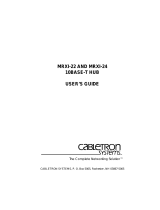 Cabletron Systems EPIM F3 User manual
Cabletron Systems EPIM F3 User manual
-
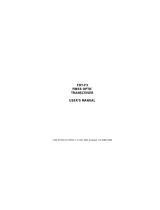 Cabletron Systems FOT-F3 User manual
Cabletron Systems FOT-F3 User manual
-
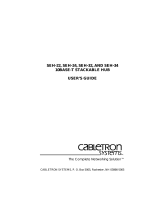 Cabletron Systems SEH-34 User manual
Cabletron Systems SEH-34 User manual
-
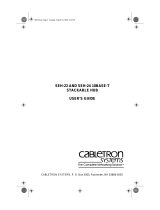 Cabletron Systems SEH-22 User manual
Cabletron Systems SEH-22 User manual
-
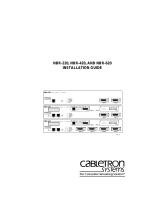 Cabletron Systems NBR-420 User manual
Cabletron Systems NBR-420 User manual
-
Enterasys Networks EPIM F3 User manual
-
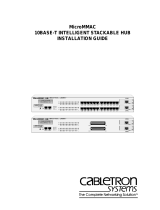 Cabletron Systems MicroMMAC-24ES Installation guide
Cabletron Systems MicroMMAC-24ES Installation guide
-
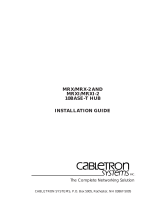 Cabletron Systems MRXI Installation guide
Cabletron Systems MRXI Installation guide
-
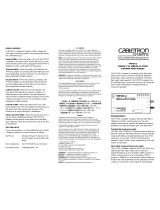 Cabletron Systems TPFOT-2 User manual
Cabletron Systems TPFOT-2 User manual
Other documents
-
Beam LBT9522B Owner's manual
-
Nikon Switch KT-10FV2 User manual
-
3com Marine Radio 5101T-FB-SMA User manual
-
Planet ET-118 User manual
-
Transition Networks E-FL/RED-SIC User manual
-
Transition Networks ETHERNET E-TBT-MC01(LC) User manual
-
Patton electronics MiniMau 2100 User manual
-
Transition Networks E-MUX-SA05 User manual
-
Transition Networks E- FL/RED-MC01(SMA) User manual
-
Bay Networks 281xSA Using Manual









